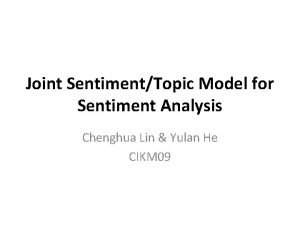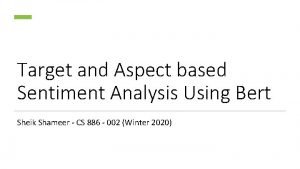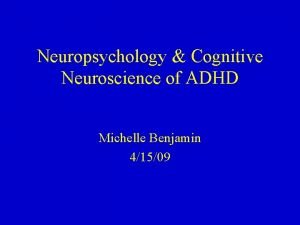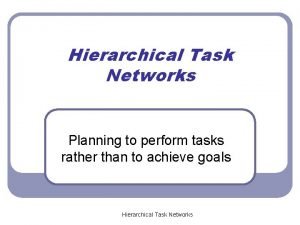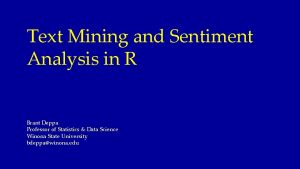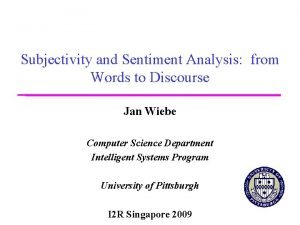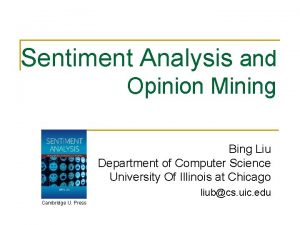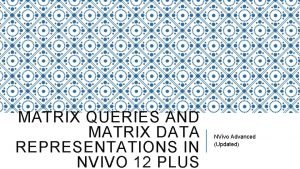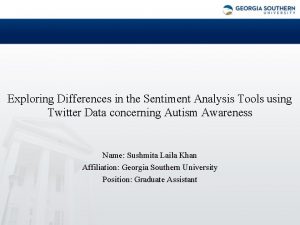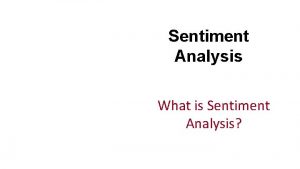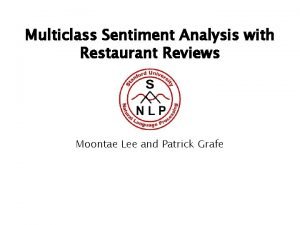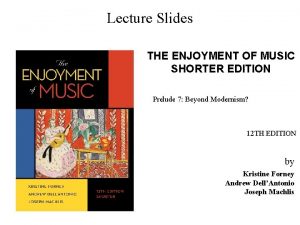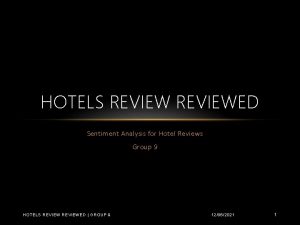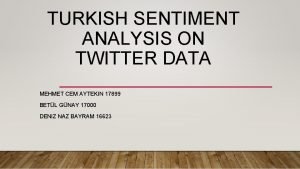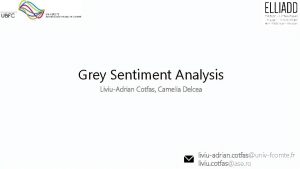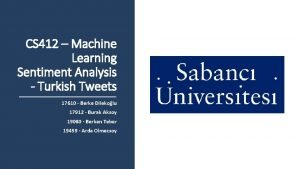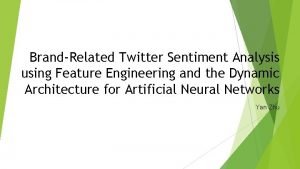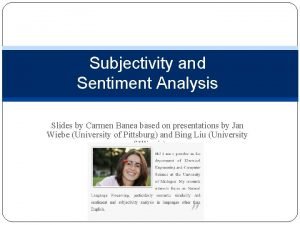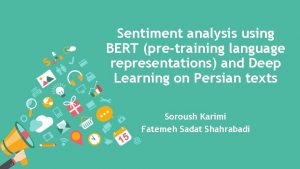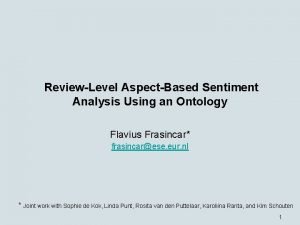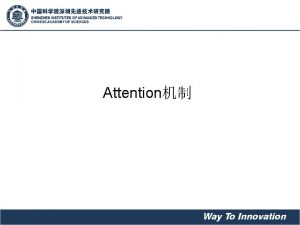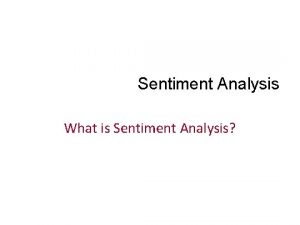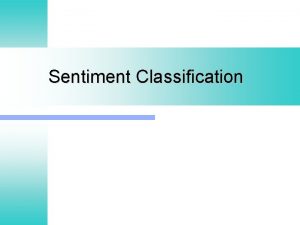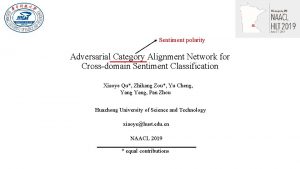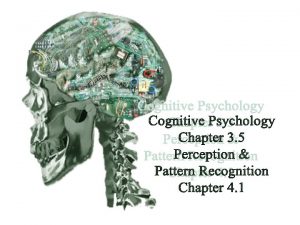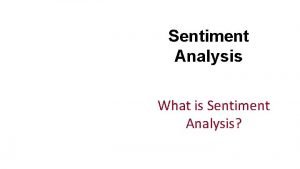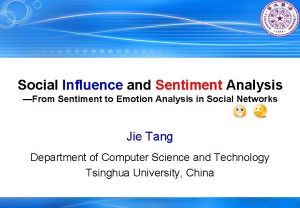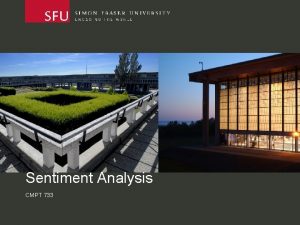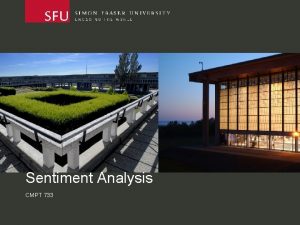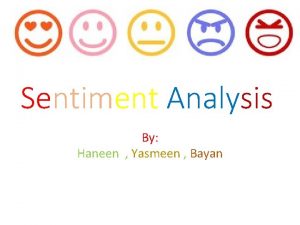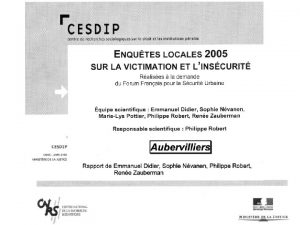Hierarchical Attention Transfer Network for Crossdomain Sentiment Classification




























- Slides: 28

Hierarchical Attention Transfer Network for Cross-domain Sentiment Classification Zheng Li, Ying Wei, Yu Zhang, Qiang Yang Hong Kong University of Science and Technology

Cross-Domain Sentiment classification Testing data Training data Books 84% Sentiment Classifier Restaurant Challenges of Domain Adaptation: -Domain discrepancy 76%

Motivation sent Books (source domain) Restaurant (target domain) Great books. His characters are engaging. The food is great, and the drinks are tasty and delicious. It is a very nice and sobering novel. The food is very nice and tasty, and we’ll go back again. A awful book and it is a little boring. Shame on this place for the rude staff and awful food. Ø Pivots(domain-shared sentiment words): great, wonderful, awful Ø It is important to identify these pivots. Useful for target domain sent

Motivation sent Books (source domain) Restaurant (target domain) Great books. His characters are engaging. The food is great, and the drinks are tasty and delicious. It is a very nice and sobering novel. The food is very nice and tasty, and we’ll go back again. A awful book and it is a little boring. Shame on this place for the rude staff and awful food. sent Ø Non-Pivots(domain-specific sentiment words): source domain: engaging, sobering… target domain: delicious, tasty… Ø It is necessary to align non-pivots when there exists large discrepancy between domains (few overlapping pivot features).

Motivation + positive - negative Ø Whether can we transfer attentions for emotions across domain? • domain-shared emotions (automatically identify the pivots) • domain-specific emotions (automatically align the non-pivots) Source A + pivots great nice - pivots awful + non-pivots - non-pivots engaging sobering boring Attention Transfer Target B great nice + pivots - pivots awful tasty delicious + non-pivots shame rude - non-pivots

+ positive Motivation - negative Ø How to transfer attention for domain-specific emotions without any target labeled data? Source A Target B + pivots + non-pivots - non-pivots Attention Transfer engaging sobering great nice boring awful - pivots tasty delicious shame rude + non-pivots - non-pivots

+ positive Motivation - negative Books (source domain) Restaurant (target domain) 1 0 Great books. His characters are engaging. The food is great, and the drinks are tasty and delicious. 1 0 It is a very nice and sobering novel. The food is very nice and tasty, and we’ll go back again. 1 0 0 1 A awful book and it is a little boring. Shame on this place for the rude staff and awful food. 0 1

Hierarchical Attention Transfer Network (HATN) HATN consists of two hierarchical attention networks: Ø P-net: automatically identify the pivots. Ø NP-net: automatically align the non-pivots. P-net Sentence representation The book is great It is very readable Input Layer +pivot list great good …. ∑ Word Embedding Layer ∑ Sentence Attention Layer Task 2: Domain Classification Gradient Reversal Layer Softmax Task 1: Sentiment classification Sentence Positional Encoding Word Positional Encoding Softmax NP-net -pivot list awful bad …. The book is *** It is very readable Word Attention Layer Document representation Sentence representation ∑ Word Attention Layer ∑ Sentence Attention Layer Softmax Task 3: +pivot prediction Softmax Task 4: -pivot prediction

P-net aims to identify the pivots, which have two attributes: • They are important sentiment words for sentiment classification. • They are shared by both domains. In order to achieve this goal, HAN Task 1: Sentiment classification Task 2: Adversarial Domain Classification The sketch of the P-net

NP-net aims to align the non-pivots with two characteristics: • They are the useful sentiment words for sentiment classification. • They are domain-specific words. To reach the goal Task 1: Sentiment classification HAN The sketch of the NP-net Task 3: +pivot prediction Task 4: -pivot prediction

Multi-task Learning for Attention Transfer P-net • automatically identify the domain-invariant features (pivots) with attention instead of manual selection. engaging sobering boring NP-net • automatically capture the domain-specific features (non-pivots) with attention. • build the bridges between non-pivots and pivots using their co-occurrence information and project non-pivots into the domain-invariant feature space. great nice tasty delicious bad awful shame rude

Training Process •

Hierarchical Attention Network (HAN) Hierarchical Attention Network: Ø Hierarchical content attention • Word attention • Sentence attention Ø Hierarchical position attention HAN Sentence representation The food is great The drinks are delicious Input Layer ∑ Word Positional Encoding Word Attention Layer Document representation ∑ Sentence Positional Encoding Sentence Attention Layer

Hierarchical Content Attention Word Attention • The contextual words contribute unequally to the semantic meaning of a sentence. The food is great The drinks are delicious … Mask softmax … MLP … The book is great

Hierarchical Content Attention Sentence Attention • Contextual sentences do not contribute equally to the semantic meaning of a document. … Mask softmax … MLP …

Hierarchical Position Attention Hierarchical Positional Encoding • Fully take advantage of the order in each sequence. • Stay consistent with the hierarchical content mechanism and consider the order information of both words and sentences. • Word positional encoding • Sentence positional encoding

Individual Attention Learning Ø The loss of P-net consists of two parts: • Sentiment loss

Individual Attention Learning Ø The loss of NP-net consists of two parts: • Sentiment loss • positive and negative pivot predictions loss

Joint Attention Learning • We combine the losses for both the P-net and NP-net together with a regularizer to constitute the overall objective function:

Experiment • Dataset • Amazon multi-domain review dataset Table 1: Statistics of the Amazon reviews dataset. • Setting Ø 5 different domains, totally 20 transfer pairs. Ø For each transfer pair A-> B: • Source domain A: 5600 for training, 400 for validation. • Target domain B: All labeled data 6000 for testing. • All unlabeled data from A & B used for training.

Compared Methods Ø Baseline methods • Non-adaptive • Source-only: only use source data based on neural network. • Manually pivot selection • SFA [Pan et al. , 2010] : Spectral Feature Alignment • CNN-aux [Yu and Jiang 2016]: CNN + two auxiliary tasks • Domain adversarial training based method • DANN [Ganin et al. , 2016]: Domain-Adversarial Training of Neural Networks • DAm. SDA [Ganin et al. , 2016]: DANN + m. SDA [Chen et al. , 2012] • AMN [Li et al. , 2017] : DANN + Memory Network

Experiment results Ø Comparison with baseline methods

Compared Methods

Experiment results Ø Self-Comparison

Visualization of Attention P-net attention NP-net attention

Visualization of Attention Books domain + great good excellent best highly wonderful enjoyable love funny fantastic classic favorite interesting loved beautiful amazing Pivots fabulous fascinating important nice inspiring well essential useful fun incredible hilarious enjoyed solid inspirational true perfect compelling pretty greatest valuable real humorous finest outstanding refreshing awesome brilliant easy entertaining sweet + Nonpivots - readable heroic believable appealing adorable thoughtful endearing factual inherently rhetoric engaging relatable religious deliberate platonic cohesive genuinely memorable astoundingly introspective conscious grittier insipid entrancing inventive conversational hearted lighthearted eloquent comedic understandable emotional depressing insulting trite unappealing pointless distracting cliched pretentious ignorant cutesy disorganized obnoxious devoid gullible excessively plotless disturbing trivial repetitious formulaic immature sophomoric aimless preachy hackneyed forgettable extraneous implausible monotonous convoluted Electronics domain - bad disappointing boring disappointed poorly worst horrible terrible awful annoying misleading confusing useless outdated waste poor flawed simplistic tedious repetitive pathetic hard silly wrong slow weak wasted frustrating inaccurate dull mediocre sloppy uninteresting lacking ridiculous missing difficult uninspired shallow superficial stereo noticeably noticeable hooked softened rubbery rigid shielded labeled responsive flashy pixelated personalizing craving buffering glossy matched conspicuous coaxed useable boomy programibilty prerecorded ample fabulously audible intact slick crispier polished markedly illuminated intuitive brighter fixable repairable plugged bulky spotty oily scratched laggy laborious negligible kludgy clogged riled intrusive inconspicuous loosened untoward cumbersome blurry restrictive noisy ghosting corrupted flimsy inferior sticky garbled chintzy distorted patched smearing unfixable Ineffective shaky distractingly frayed

Conclusion • We propose a hierarchical attention transfer mechanism, which can transfer attentions for emotions across domains by automatically capturing the pivots and non-pivots simultaneously. • Besides, it can tell what to transfer in the hierarchical attention, which makes the representations shared by domains more interpretable. • Experiments on the Amazon review dataset demonstrate the effectiveness of HATN.

Thank you!
 Joint sentiment topic model for sentiment analysis
Joint sentiment topic model for sentiment analysis Aspect based sentiment analysis using bert
Aspect based sentiment analysis using bert Michelle benjamin phd
Michelle benjamin phd Hierarchical network design
Hierarchical network design Hierarchical task network planning
Hierarchical task network planning Repeating disturbance that transfers energy
Repeating disturbance that transfers energy Pyspark twitter sentiment analysis
Pyspark twitter sentiment analysis Text mining and sentiment analysis in r
Text mining and sentiment analysis in r Subjectivity in sentiment analysis
Subjectivity in sentiment analysis Bing images
Bing images Sentiment analysis nvivo
Sentiment analysis nvivo Sentiment analysis tools comparison
Sentiment analysis tools comparison Twitter sentiment
Twitter sentiment Sentiment analysis of restaurant reviews
Sentiment analysis of restaurant reviews Chapter 68 underscoring meaning
Chapter 68 underscoring meaning Sentiment analysis for hotel reviews
Sentiment analysis for hotel reviews Turkish sentiment analysis
Turkish sentiment analysis David delcea
David delcea Turkish sentiment analysis
Turkish sentiment analysis Azure twitter sentiment analysis
Azure twitter sentiment analysis Slide to doc.com
Slide to doc.com Sentiment analysis with deep learning using bert
Sentiment analysis with deep learning using bert Sentiment analysis conclusion
Sentiment analysis conclusion Public sentiment is everything
Public sentiment is everything Abolitionist sentiment grows
Abolitionist sentiment grows Iso 22301 utbildning
Iso 22301 utbildning Typiska drag för en novell
Typiska drag för en novell Tack för att ni lyssnade bild
Tack för att ni lyssnade bild Returpilarna
Returpilarna
